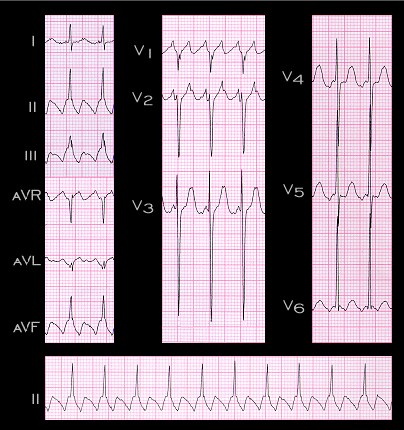In atrial flutter, the atrial deflections seen on the body surface electrocardiogram are referred to as "f waves" or "flutter waves". They are characteristically rapid and regular with a saw-tooth configuration. In type I atrial flutter, the flutter rate is usually in the 250-350 per minute range and there is usually 2:1 AV block so that the ventricular rate is usually around 150 per minute. However, in younger individuals the AV nodal refractory period may be shorter, and capable of allowing 1:1 conduction, whereas in older individuals and those on a variety of cardioactive drugs, the AV nodal refractory period may be prolonged causing higher grades of AV block and a slower ventricular rate. The rhythm may be regular or irregular, depending on the consistency of the AV nodal block.

The tracing shown here is from a 71 year old male. It illustrates the most common ECG presentation of type I atrial flutter. The negative flutter waves in leads II, III and aVF reflect the fact that the counter-clockwise atrial depolarization in the anterior portion of the right atrial reentry circuit occurs in a caudal to cephalic (i.e.superior) direction. The rate of the flutter waves in this example is 300 per minute and there is 2:1 AV block which is constant. This results in a regular ventricular rate of 150 per minute. The increased R and S wave voltages in the precordial (chest) leads suggest LVH.
